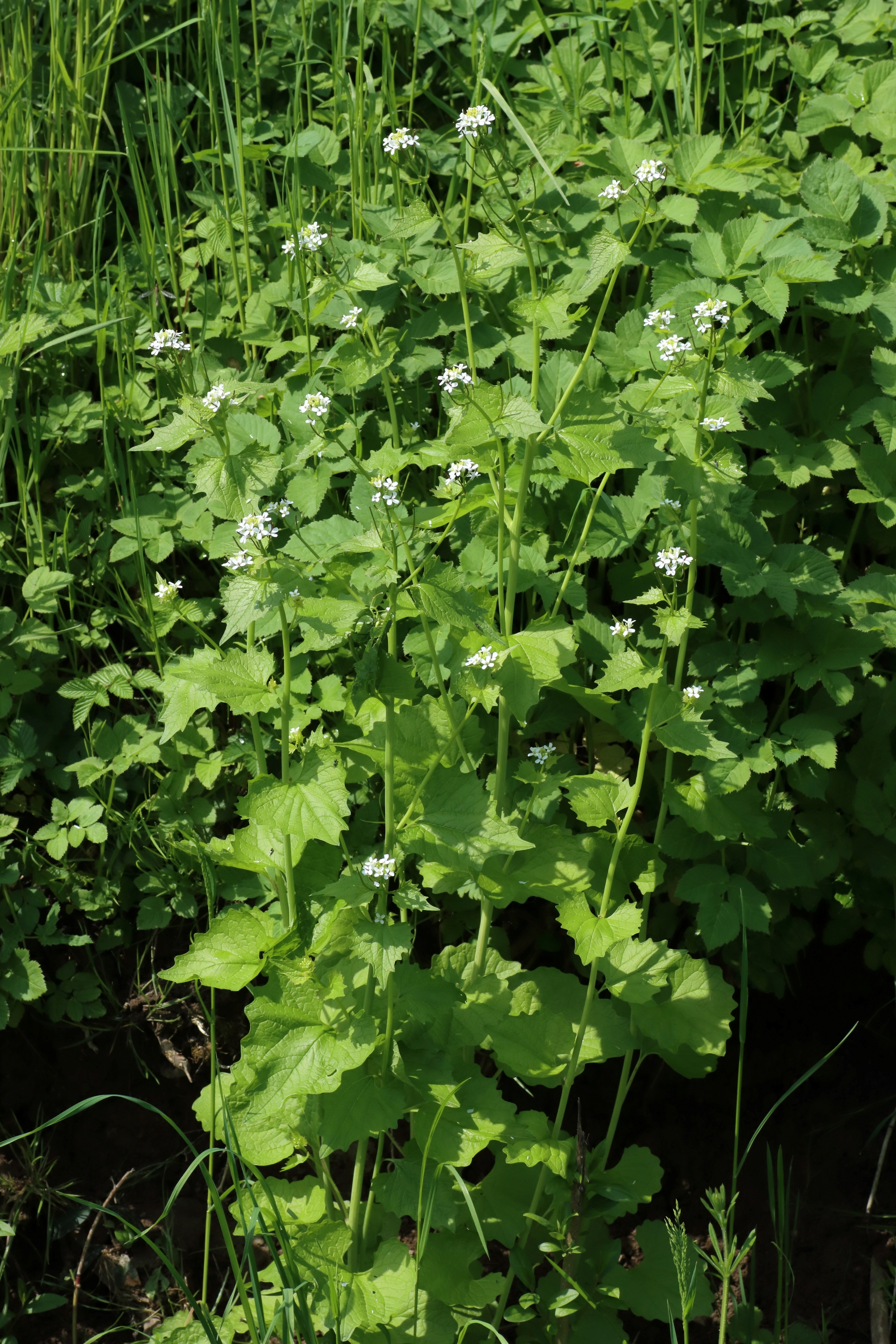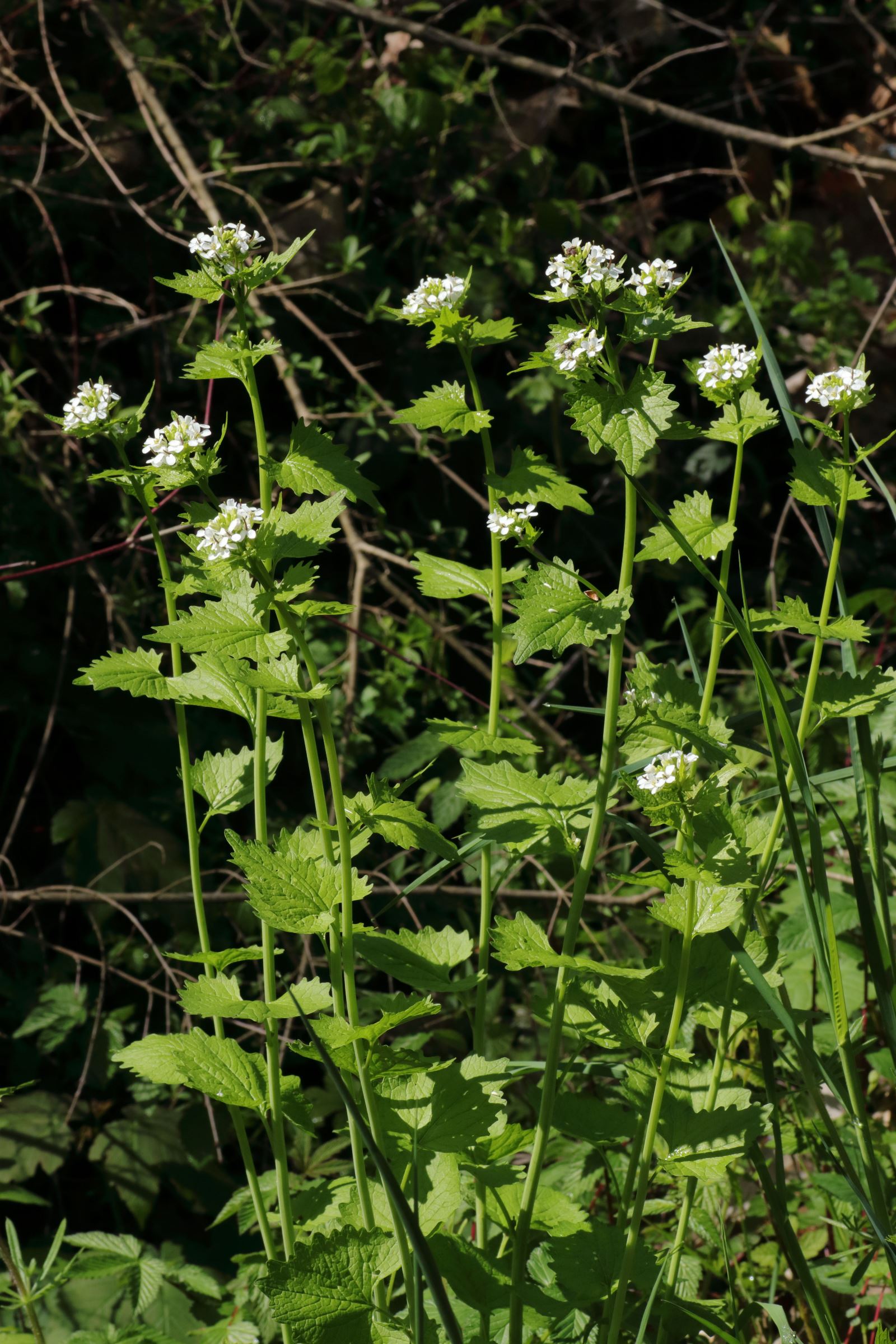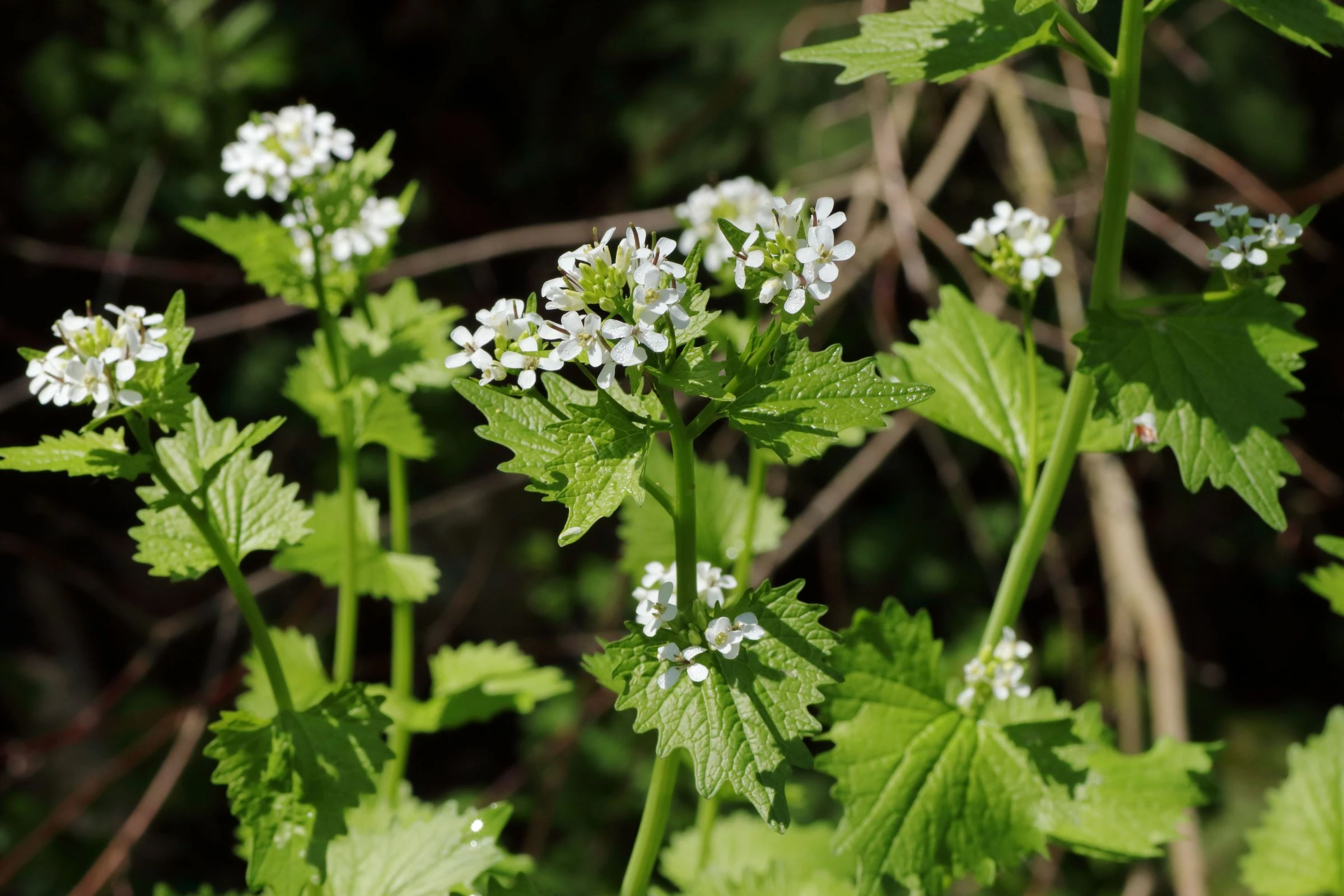The common garlic mustard has a slightly garlicky flavour. But it is not only us humans who like these plants. The blossoms are also an important source of food for butterflies in spring.



Occurrence and distribution: The garlic mustard is mainly found in sparse hardwood forests, along hedges, roadsides, in parks and gardens. It prefers semi-shady, nutrient-rich and humus-rich clay soils. It is a nitrogen indicator plant and a semi-shade plant. The plant is rarely found in the branches of trees – source: Taschenlexikon der Pflanzen Deutschlands und angrenzender Länder. The garlic mustard can be found from the plains to the low mountain ranges. It was imported to North America.
Plant description
Growth habit: The garlic mustard reaches a height between 20 cm and 100 cm. Rarely, the plants are also smaller in very meagre locations. It is a biennial, herbaceous plant. The below-ground part of the plant consists of a long taproot. From this a slightly square stem forms with a weak hairs in the lower part.
Leaves: A rosette of leaves forms close to the ground in the first year. The long-stalked, kidney-shaped leaves are arranged in the rosette. The individual leaves have a notched edge. The stem leaves are arranged alternately on the stems. The upper side of the leaves has a greenish colour. The stem leaves have a triangular shape.
Blossoms: The grape-like clusters of flowers are located at the end of the stems. They are clustered in dense flowers. The individual blossoms consist of four white petals and are between 5 and 8 mm in size. The flowers have a radial structure and belong to the group of disc flowers. The nectar is formed in them. All flowers are hermaphroditic. The sepals under the petals have a greenish colour. The nectar glands are located at the base of the blossoms.
Fruits: The fruits consist of 6 cm long pods. They are spring fruits. Up to eight seeds can form per pod. The individual seeds are roundish and black in colour. They are spread by wind and animals. Some of the seeds are also spread by ants. These are mainly deposited on wicker. The fruit ripens in June to July. The main spreading occurs through root shoots.
Special features of the plant
Pollination of the blossoms: Pollination of the blossoms is carried out by spring midges, bees, flies, hoverflies and beetles, among others, and the blossoms are also a good source of food for many butterflies. Spontaneous self-pollination is common. The flowering period lasts from April to July.
Special features of the leaves: When the leaves are crushed or rubbed, they can develop a slight garlic smell. This can be used to identify the plant. However, it should not be relied on as the sole means of identifying the plant.
Cultivation of the plant: The plant can be bought as seeds in specialised shops. The plant is suitable for a shady to semi-shady location. It prefers nutrient-rich, humus-rich soil. The seeds can be sown as early as October, as they are cold germinators. They need at least 1 frost. The plant is perennial.
Threats of garlic mustard to trees: The European garlic mustard is considered a neophyte in America. In America, unlike in Europe, the plant mainly colonises the undergrowth of forests. The roots of the garlic mustard are considered harmful to tree roots. They inhibit the development and growth of the “mycorrhiza fungi” necessary for trees. In some cases, they can also destroy trees. European trees have adapted to this “weakening” to some extent. While especially the seedlings of the North American relatives are very susceptible to the inhibition. Large plantings of the plant can partly also cause damage to older trees.
Use in cooking and as a medicinal plant
Use in the kitchen: The chopped leaves have a pleasant, garlicky aroma. The seeds have a mustard-like aroma, so the plant parts are suitable for seasoning dishes. The herb should be used sparingly however, as it is very spicy. The blossoms can be used as edible decoration in the kitchen. The leaves and shoots should be used raw or only lightly cooked, otherwise they lose their flavour.
Use as a medicinal plant: Garlic mustard no longer plays a major role in medicine. In folk medicine it is used to treat insect bites and worm diseases. The ingredients have an antiseptic, mild diuretic and expectorant effect. They are also effective against asthmatic complaints.
Ingredients: Mustard oil glycosides, saponins, vitamin A, vitamin C, essential oils.
Nectar source for butterflies
Nectar supplier for butterflies: The blossoms are an important nectar source for many butterfly species in spring and early summer. These butterflies include the aurora butterfly (Anthocharis cardamines) and the forest board butterfly (Pararge aegeria). For the aurora butterfly, the plant is also considered a caterpillar food plant. The caterpillars of day and night butterflies such as the agate owl (Phlogophora meticulosa) and green vein white butterfly (Pieris napi) also feed on the plant.
Folk names & name origin
Folk names: There are several vernacular names for the common garlic mustard in old literature. These include garlic heath, leek herb and hedge mustard. – Source: Taschenwörterbuch für Botaniker und alle Freunde der Botanik – Prof. Dr. Glaser
Origin of name: The botanical genus name “Alliaria” is derived from the Latin word “Allium”, the generic name for onion and leek species. The German name “Knoblauchsrauke” (garlic mustard) refers to the garlicky smell when the leaves of the plant are crushed.
Endangerment of the plant
Endangerment of the plant: On the Red List of Threatened Species, this plant is classified as “not endangered” in Germany.
Distribution codes: A, AV, M1, M2, F, K